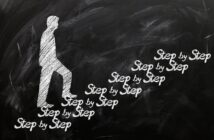Presentation skills and the ability to deliver a “sales pitch” determines success within sales. Whether it’s through a cold call, product demo or client meeting – we all need to know how to pitch our product and deliver a compelling message that resonates with a potential client.
Sales organizations invest thousands of dollars and countless hours into helping sales reps pitch more effectively. They work with reps to strengthen their product knowledge so they sound like an expert in their field. They teach them how to ask good questions so they can build connection and identify business challenges. And they make the sales rep practice their tone and pace so they sound more confident.
All of these strategies work and will help a sales rep close more sales, but only if the sales rep is fully present during their sales pitch. In this podcast, Dr. Michael Gervais provides an excellent definition of what it means to be “present” and in the moment:
“Being present is when your body and your mind is in the same place and focused on the same thing.”
Only when we’re present can we effectively leverage our presentation skills and deliver a compelling message. Most sales reps can struggle with this because making a cold call to a stranger or delivering a presentation to a potential buyer is an extremely vulnerable experience. These situations are filled with uncertainty, risk of failure and exposes us to potentially hurtful emotions.
Sales Anxiety & Egos
In response to these situations, our anxiety senses we’re in danger and our ego enters self-protection mode. It starts imagining future scenarios and concocting stories of failure filled with embarrassment, hurt and fear. Our stomachs churn, our breathing quickens and our mouths dry up just as we’re about to start pitching.
During these moments our presentation skills will hardly matter. It’s in these moments when our success in sales depends on being able to find our way back to the present. Only then can we execute a perfect sales pitch using all of the product knowledge and training that we have been given.
Setting Up The Perfect Sales Pitch
Like a basketball player standing on the free throw line with the game on the line or a golfer teeing off on the 18th hole; every athlete has a routine they follow during stressful situations to remain laser focused on the present moment.
Salespeople are corporate athletes and also require a pre meeting routine that gets them ready for their sales pitch. Below are seven strategies we can use to build our own routine, remain mentally present and keep anxiety in check.
1 – Altruistic Mindset
I’ve written about the power of adopting an altruistic mindset but it’s worth repeating here. The Dalai Lama has stated that one of the best cures for anxiety is altruism. When anxiety, fear of failure and self-doubt have us entangled in a web we must remember:
In these moments, we’re only focused on serving ourselves.
When we adopt an altruistic mindset we become selfless and put the well-being of others ahead of ourselves. Before a sales pitch, we need to make sure our attention is focused on the buyer’s well-being and the experience we’re trying to create for them.
As one of my favorite sales leaders Kevin Dorsey frequently writes on LinkedIn:
“It’s not about YOU. It’s about THEM.”
When we do this, the web disappears and we’re able to find peace, calm and joy in the present. This happens because we stop focusing on serving our Ego and instead focus on serving our buyer.
2 – Visualization
Sales coaches sometimes tell their sales reps to visualize their perfect sales pitch before the meeting or call. They ask their reps to create a mental image and visualize what they’re thinking, feeling and saying to the customer. Though this method can be effective, it puts the attention back on YOU – the sales rep – which can activate our anxiety.
Instead of visualizing about ourselves, we need to visualize a day in the life of our buyer. Imagine ourselves in the buyer’s shoes and then reflect on these questions:
- How are they spending their day?
- What challenges are they facing without our product?
- When they encounter these challenges what emotions are they feeling?
The more detail – the better. Try to fill your visualization with as many sounds, colors and emotions to make it as real as possible.
This exercise will also help us flex our empathy muscles that we’ll need throughout our pitch.
3 – Actually Be “Empathetic”
Far too often “empathetic” is freely used to describe how salespeople should approach their prospects. Unfortunately it has never been properly defined for salespeople, which means there is a lot of fake empathy being used in sales.
According to Scott Barry Kaufman in his book Transcend, to be truly empathetic you must combine two types of empathy: Cognitive & Affective Empathy.
Cognitive Empathy is the ability to understand another person’s perspective and see things from their point of view. Salespeople high in cognitive empathy would agree with statements like:
- “I can identify challenges my buyer may be facing before they tell me”
- “I know when a potential buyer is upset before they say why”
- “I’m able to easily see things from a buyer’s perspective”
Most “empathy” in sales stops here and falls short of what it means to be “empathetic”. If we’re simply exploiting a buyer’s weaknesses to benefit our selling, then we’re being manipulative.
Many of us need to work on our Affective Empathy – the ability to feel what a buyer is feeling and live their emotional experience. Salespeople high in affective empathy would agree with statements like:
- “I’m able to feel the buyer’s pain when they tell me about X challenge”
- “I would feel disappointed if my product let the buyer down after purchase”
- “I would feel upset if the buyer bought the wrong solution”
If we’re not feeling our buyer’s emotions, we’re not being empathetic. We need to make sure both Cognitive and Affective empathy are being engaged as part of our visualization exercise.
Project Mamba: Stop Letting Stress Impact Your Commission Check
4 – You Must Believe In Your Product
In it’s simplest form, sales is the transfer of emotions and beliefs about our product to the buyer. If we don’t believe our product will offer any value, then our buyer will likely feel the same way.
This transfer of emotion happens due to a phenomenon called emotional contagion. It happens when we unconsciously start to mimic the emotions and expressions of others around us.
Recent research in neuroscience shows mirror neurons in our brain help us share emotional experiences, build empathy and connect with others. This is why we feel joyful and happy when a friend shares good news like landing a new job. Mirror neurons allow us to share our friends experience and positive emotions together.
Unfortunately, mirror neurons can also transfer negative emotions too. You’ve likely felt this phenomena with COVID spreading panic through your team, community and household. During our sales pitch, if we’re feeling distrust in our product, our emotions will easily transfer to a potential buyer.
Fake It Till I Make The Sale?
You might be thinking – “I don’t believe in my product, but I can fake it.”
Though this might be possible with smaller clients, it will be much harder to “fake it” during a sales pitch with a large client. Larger clients usually increase the “stakes” because working with them means you have more to gain and more to lose.
This is relevant because psychologist Paul Ekman discovered that humans can create over 10,000 different facial expressions; 3,000 of which are related to emotion. Faking it means we’re trying to control these facial expressions and hide how we’re feeling from from the buyer.
This can be extremely difficult. According to Ekman, we all have micro-expressions that are involuntary facial expressions that reveal how we’re truly feeling. Since they’re involuntary, they become much harder to hide in high pressure situations like a “tell” in poker.
Similar to a poker player who has a “tell” that reveals their bluff, we’re most likely going to have a “tell” that reveals when we’re faking it. Especially when pressure is high during a sales pitch with a major client.
Believing In Our Product
We can ensure our micro-expressions are transferring the right emotions and beliefs by simply believing in our product. An easy way to do this is to reflect on a client who benefited from using our product before our sales pitch.
During this reflection, we want to feel the relief, confidence, happiness and other positive emotions our product created for our client. The better we get at visualizing and feeling their emotions, the easier it will be to believe in our product and carry this belief into our presentation.
Often in sales, we underestimate how important positive client experiences can be to our Mental Health and resilience. We’re always in a rush to make the next sale and quickly move on after the deal is closed. As a result, we miss hearing stories about how we’ve helped changed someone’s life for the better.
We can improve our confidence and strengthen our beliefs in our product by simply calling a few past clients. All we need are two or three client success stories we can reflect on and emotionally connect with in a meaningful way. These stories will help us remain confident and counter conflicting beliefs about our product when we’re feeling doubtful.
5 – Calming Your Nerves Before Your Sales Pitch
Breathwork and understanding how our autonomic nervous system works can help us remain present and calm our nerves before our sales pitch. This means we will sound more confident and prevent any fear or anxiety we’re feeling from transferring to the buyer.
The autonomic nervous system regulates involuntary physiologic processes including our heart rate, blood pressure, respiration digestion and sexual arousal.
It is broken down in to two halves:
Part 1 – Parasympathetic Nervous System:
This half of the system stimulates rest, relaxation and restoration. It helps deliver feel good hormones like serotonin and oxytocin into your bloodstream. As a result we’re more compassionate, calm, confident, warm and can connect better with others. The ideal state we want to be in when making a sales pitch.
Part 2 – Sympathetic Nervous System:
The second half of the system is responsible for our fight or flight response that quickly activates in response to danger. Adrenaline and cortisol flood our bloodstream, which increases our heartbeat and rate of breathing. They will also cause our muscles to tremble or tighten as they get ready for action.
As you can imagine, these adaptations are helpful when facing a bear and less so before a sales pitch. When this system is engaged, we’ll sound scared, unsure and frantic making it nearly impossible for a buyer to trust us as an expert.
Identify Which System Is Engaged
Prior to jumping into a call or meeting with a buyer – we can use our breath to check which system is engaged. If we’re nervous or anxious before our sales pitch, we’ll likely be taking quick and shallow breaths. This is a sign that our sympathetic nervous system is in the driver’s seat.
Don’t panic – it’s normal to unintentionally be in fight or flight mode.
As mentioned earlier, delivering an important sales pitch yields a high degree of uncertainty, risk of failure and emotional exposure that we may be rejected. Our self-protection system perceives this situation as a threat and something the body needs to defend against.
During these moments we can use breathing exercises to help us engage our parasympathetic nervous system and calm ourselves down.
Breathing Exercises
As James Nestor explains in his book Breath, breathing is a power switch we can use to toggle between both halves of the autonomic nervous.
Nerves stimulating the sympathetic nervous system are found near the top of the lungs and activated with short shallow breaths. Nerves stimulating the parasympathetic nervous system are found in the lower lobes of lungs. This means we can stimulate the lower regions of the lungs with long deep inhales and exhales that will shift us into a more relaxed state.
Here are two breathing techniques Nestor outlines in his book that can help you get ready for your sales pitch:
Exercise #1 – Box Breathing
Used by Navy Seals in tense situations and hands down my favorite. I use this method before every big presentation and when I wake up anxious in the middle of the night. To execute this method, simply think of a box with four sides:
Inhale for 4 seconds; hold your breath for 4 seconds; exhale for 4 seconds and then hold for 4 seconds. Then repeat for at least six rounds or more.
Nestor explains longer exhalations will elicit an even greater parasympathetic response. He offers a variation of this method which is executed as follows:
Inhale for 4 seconds; hold your breath for 4 seconds; exhale for 6 seconds and then hold for 2 seconds. Then repeat for at least six rounds or more.
Just make sure this second variation doesn’t make you too sleepy or relaxed before your sales pitch.
Exercise #2 – The Perfect Breath
Whether it was through prayer, meditation or some other spiritual practice – every ancient civilization had almost exactly the same breath cycle. Now being tested and confirmed with modern science, Nestor explains the “perfect breath” rate is 5.5 breaths per minute. To achieve this breath rate, simply breathe using the following pattern:
Inhale for 5.5 seconds and then exhale for 5.5 seconds. This is almost exactly 5.5 breaths per minute.
I’ve been experimenting with both methods and have found the “perfect breath” to be equally as effective as box breathing when done for at least 10 minutes. This may be different for you so make sure you try both.
If you’re worried about timing your breaths correctly, Paced Breathing app is free and will keep you on pace.
Regardless of which method you use, always make sure you’re breathing deep into the belly to help pull the air lower into the lungs. This will help flip on the parasympathetic nervous system and get you ready for your sales pitch.
Project Mamba: Stop Letting Stress Impact Your Commission Check
6 – Listen To Music
In addition to breathing, music can also help relieve our anxiety and bring us into the moment. In Mihaly Csikszentmihalyi’s book Flow, he describes music as organized auditory information that organizes the mind and channels emotion.
Prior to a sales pitch our mind can be chaotic and thoughts can feel fragmented. It cycles between trying to remember what we’re going to say, while also tending to all the anxious thoughts and fears of what might happen if we fail. We get stuck trying to control things that might happen in the future, which only leaves us feeling more overwhelmed in the present.
Music breaks this cycle. It provides order and organization for our mind in the present. Especially if the song or melody is meaningful to the person listening to it.
Find Your “Go-To” Song
For myself, I listen to Bring It On Home To Me by Sam Cook and The Chain by Fleetwood Mac before every presentation. I’m deeply connected to both of these songs because I listened to them on repeat during my fight with testicular cancer.
First I start with Bring it On Home To Me because it fills me with gratitude and joy as I think about my girlfriend, friends and family that supported me through surgery. Then four minutes before my sales pitch I listen to The Chain. The slow build and steady beat of the drum filled me with confidence and calm before my surgery and continues to do so before every sales pitch.
Every salesperson needs to have one or two songs like this in their pre sales pitch routine. Songs that are so powerful that our anxiety melts away and our mind locks in. The type of songs that when heard – wake your body up, give you chills and bring out the emotions you need in that moment.
7 – Script Your Sales Pitch
Having a script to follow is one of the most divisive topics in the sales world. Those “against” having a script say that a script makes them sound robotic and unnatural. Those “for” a script say it provides them with a plan and a structure they can follow.
I hate to choose sides, but the research vastly supports those in favor of using a script.
Famous psychologist Robert Epstein surveyed over 30,000 people in 30 countries. His research found that the most effective method for reducing stress was having a plan. Having a plan means we think about obstacles ahead of time and consider ways to overcome them. This makes us feel in control and motivates us to act even when an uncertain situation has us feeling stressed.
This is why scripts and objection handles are so effective – they’re really good plans. When used correctly they are extremely effective at providing confidence and improving our sales pitch.
The key to making them work is practice.
Every great actor who turns a movie script into a compelling performance has spent hours rehearsing their lines. A salesperson needs to invest the same amount of time using a script to practice their pitch. We usually only get one chance to pitch a buyer so we better make our performance count and deliver a compelling message.
Key Take-Aways For The Perfect Sales Pitch
This has been a longer post than usual. To summarize the 7 ways to stay calm and make a perfect sales pitch, I’ll walk you through my process using the strategies above.
Before every Sales Health Alliance presentation or sales pitch I follow these steps:
- Take my ego, desires and needs out of the picture. Think about who I am serving and focus on delivering an amazing experience to them. Usually this is a group of salespeople and sales leaders.
- Visualize a salesperson struggling with their Mental Health. Visualize them not sleeping, feeling disconnected from work and scared to open up about their struggles. Think about them getting rejected, starting at “0” each month or being micromanaged by their manager.
- Empathize and feel the anxiety, anger, fatigue, frustration, loneliness, fear and unhappiness that each situation creates for them. Reconnect with these emotions through similar experiences I’ve had during my own sales career.
- Strengthen my beliefs around the importance of Sales Health Alliance. Reflect on stories salespeople have shared about the positive impact a presentation, blog post or workshop has made on their Mental Health.
- Calm my nerves and engage the parasympathetic nervous system by box breathing for 3-5 minutes.
- Fill myself with joy, gratitude and confidence by listening to Bring It On Home to Me and The Chain.
- Pull out my script so I have plan that makes me feel in control of any obstacles I may face in the future.
This Is Your Moment
This entire routine takes about 15 minutes to execute, but is well-worth it. It ensures I’m able to remain present, find calm and deliver a meaningful experience to whomever I’m speaking with. It allows me to control what I can control and in doing so sets me up to by my best self.
Eminem said it best in his Grammy award winning song Lose Yourself:
“If you had one shot… Or one opportunity… To seize everything you ever wanted…
Would you capture it?
Or let it slip?
Your next sales pitch is your moment. Make sure you’re calm, ready and prepared to capture it.
For more ways to improve sales performance, resilience and well-being through better Mental Health; check out the online course below.
Project Mamba: Stop Letting Stress Impact Your Commission Check
About The Author

Jeff Riseley is currently the Founder of the Sales Health Alliance and Mental Health Advocate. With over a decade of sales experience – Jeff understands the importance of Mental Health in achieving peak sales performance.
Jeff combines his sales (Sales Knowledge Institute) and Mental Health expertise to improve sales performance through a mix of sales mentorship and mental health best practices. His strategies have helped sales teams improve their sales process, while helping them become more motivated, resilient and better equipped to tackle stressful events within sales.
He is currently delivering these strategies through on-site workshops, coaching and speaking engagements. To explore working with Jeff contact him at [email protected]





2 Comments
Pingback: How To Bounce Back From Rejection in Sales - Sales Health Alliance
Excellent tips Jeff!
I just started implementing them today on my 2nd sales day and I am seeing results!